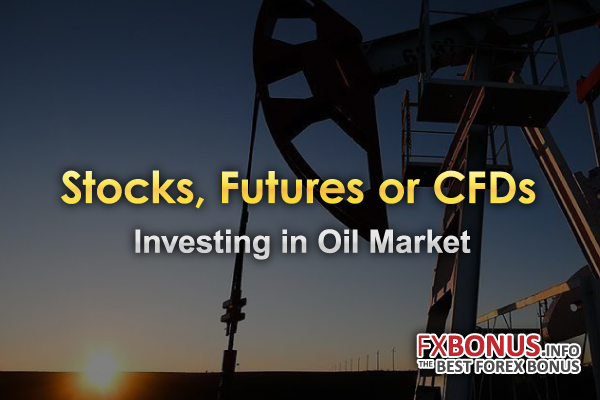Invest in Oils. Table of Contents
- Oil Stocks, Futures, or CFDs?
- How to trade oil futures CFD?
- 1. There are no special "oil" indicators
- 2. All standard technical analysis tools are used
- 3. Volumetric Analysis Techniques - For Stock Data Only
- 4. Investing in oil requires tough money management
- 5. Oil reversal must be reliable
- 6. Reaction to news is always short-term
- 7. Correlation with oil is proactive
- Conclusion

Oil Stocks, Futures, or CFDs?
Whether you are investing in oil futures or investing in oil production – and the size of your capital, the potential profit will always depend on your optimal, intelligent market behavior. You need the right choice of a trading asset and a reliable strategy.
After the rejection of the price system, tightly regulated by OPEC, and the appearance in 1983 on the New York Mercantile Exchange of the first futures contracts, first for crude oil and gas condensate, and then for refined products, the strategic raw materials market became available to almost every trader.
Today, more democratic futures, mini-contracts, indices, and exchange CFDs turned out to be beneficial not only for short-term speculators but also for industrial market participants, since such assets successfully ensure both the seller and the buyer against almost all risks of the oil and oil products market.
How to invest in oil and earn stable income?
How to trade oil futures CFD?
For those who can invest a little capital in oil, the OTC market offers a Contract For Difference (CFD or spot oil) contract, which works with commodity assets without actual deliveries – earnings are made only on the exchange rate difference. The buyer and the seller make a certain rate forecast, and the transaction is an analog of a “paper” agreement that at the moment of closing the mutual settlement will be made, and the party whose forecast turned out to be incorrect will pay the price difference to its counterparty.
CFD quotes correspond to prices when trading oil futures (brent, WTI, Urals – respectively) and the actions of CFD traders do not put pressure on the value of the underlying asset. For CFDs, there is no hard volume of the transaction (you can buy/sell non-standard or fractional volumes), and there is also no expiration (closing) of the contract, and the transaction can be kept open for a long time.
We warn you right away:
1. There are no special “oil” indicators
Regardless of the form of investment, the price of Brent oil, WTI or Urals, as well as the price of shares of oil companies is formed according to the classical exchange principles
Differences between WTI, Brent Crude, and Dubai/Oman Crude Oils
2. All standard technical analysis tools are used
Indicators work according to the standard scheme, trend instruments based on the calculation of the average give more accurate signals, oscillators are recommended only with long parameters.
tart investing in Oils (Energies) on FXCM
3. Volumetric Analysis Techniques – For Stock Data Only
It does not matter how you trade oil futures or CFD contracts, in a regular Forex terminal you only have access to tick volume, the incorrectness of which affects the technical picture much more strongly than for currency pairs. The analysis of oil volumes should be carried out on real exchange volumes, which can be accessed in exchange terminals such as Thinkorswim or MarketDelta, otherwise the confidence in volume patterns, for example, according to the VSA method, is practically zero.
Start Investing in Gold and Oil on FBS
4. Investing in oil requires tough money management
The collateral value of a standard oil lot is quite high, while price jumps in both directions by 70-100 points, and a daily range of 2-3 figures is normal. Despite the strong volatility, scalping as the main strategy for trading oil futures is strongly discouraged, otherwise, both your deposit and your trading enthusiasm can quickly end.
Start Trading Oil/USD on Deriv
5. Oil reversal must be reliable
Reversal levels must be confirmed on older periods, although in the zone of strong support/resistance (of course, with the support of the foundation), the price can move for a long time. Please note that for oil this range is usually at least ± 50 pips.
Start investing in Oils and Gas on AvaTrade
6. Reaction to news is always short-term
Speculative jumps on statistics, events, or news on oil usually give a strong reaction, but even if as a result the previous trend is maintained or a new one is formed, a reverse pullback on such a force majeure is a must. If you decide to invest real money in oil, then get in the habit of constantly studying information about the location of large options (volume, price, date, and time of closing), since before the moment of expiration the market will short-term “push” the price to these levels, and from both sides.
Invest in Oil and Gas CFDs with XM
7. Correlation with oil is proactive
Analyzing Intermarket links can be very helpful. Forex assets use their oil correlation as a leading indicator (for themselves!). For example, CAD is highly correlated with WTI oil prices as Canada is one of the largest exporters; similarly, Japan, Australia, and New Zealand are highly dependent on imports of these raw materials.
What’s the correlation of Crude Oil and Natural Gas prices?
Conclusion
Oil as a trading asset is interesting for its consistently high liquidity and volatility, but working with it requires knowledge, patience and a decent deposit, despite the abundance of mini-assets and cent accounts. For beginners without confident successful experience on less dangerous (for example, foreign exchange) assets, it is contraindicated to trade oil.
For those who respect the market and are ready to constantly work on themselves, investments in oil always give stable profits.


 IronFX
IronFX
Comment by Diletta
March 26, 2024
Awesome bonuses, good leverage. A few hiccups, but support rocks!